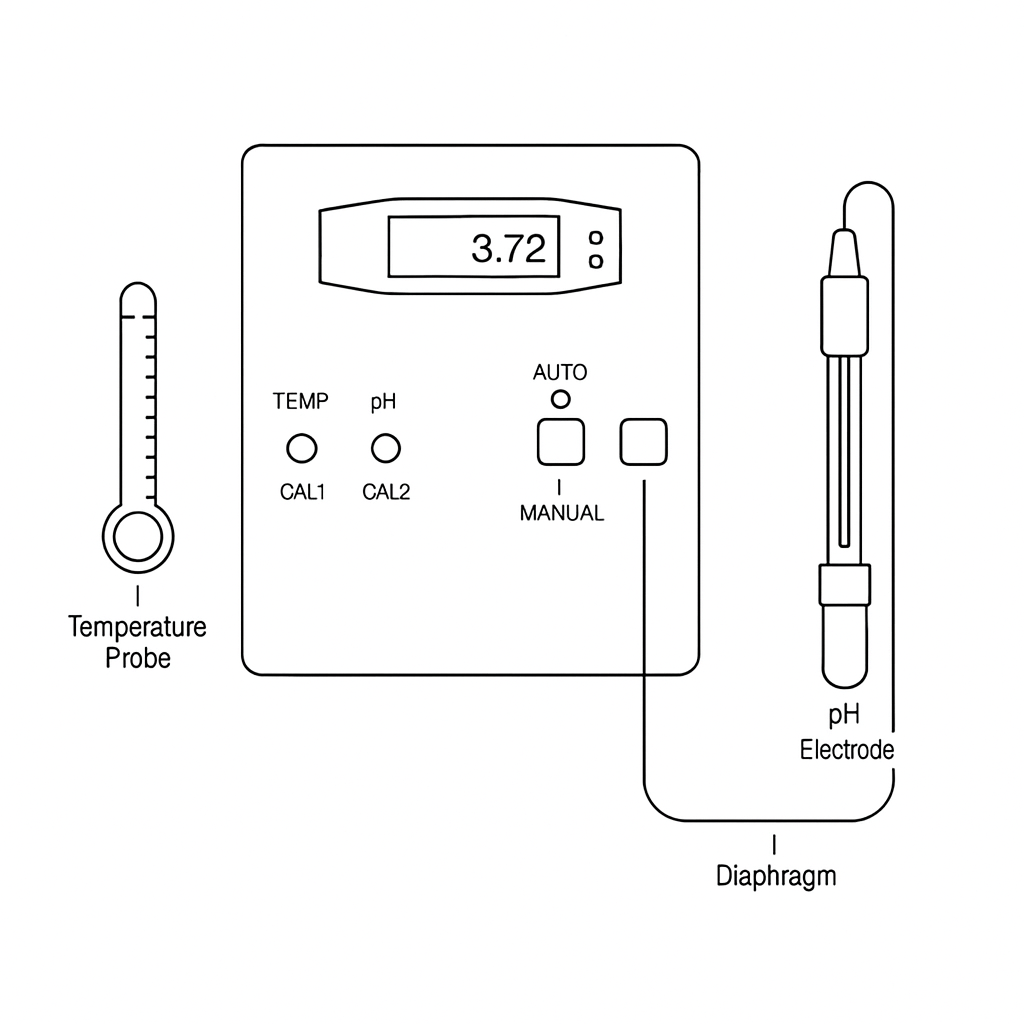What is a pH Meter? Learn Its Principle, Types & Internal Diagram
.png)
Gaurav Malhotra-Testing Instrument Expert
17-06-2025
In the fields of chemistry, biology, agriculture, water treatment, and food processing, measuring pH is critical to maintaining quality and accuracy. A pH meter is an essential analytical instrument that determines the acidity or alkalinity of a solution. Whether you're testing drinking water, soil, or industrial liquids, a pH meter offers precise results and consistent monitoring.
In this blog, we’ll explore the pH meter principle, its types, working mechanism, digital pH meter diagram, and common applications. We’ll also provide a simple step-by-step procedure of pH meter usage, a comparison table, and frequently asked questions.
Exploring What a pH Meter Is and How It Works
A pH meter is a scientific instrument that measures the hydrogen ion concentration (pH) in a liquid solution. It expresses how acidic or basic the solution is, on a scale of 0 to 14:
- pH < 7: Acidic
- pH = 7: Neutral
- pH > 7: Basic (Alkaline)
The device displays this measurement digitally or via analog output, depending on the model.
.png)
pH Meter Principle
The PH meter working principle is based on electrochemical potential difference. It compares the voltage between two electrodes—-the glass electrode (measuring electrode) and the reference electrode. When immersed in a solution, the glass electrode develops a potential relative to the pH of the solution. The reference electrode maintains a constant potential.
The pH meter amplifies the difference and converts it into readable pH units.
Formula Used:
E = E₀ + (2.303 × RT/nF) × log [H⁺]
Where:
- E is the potential,
- R is the gas constant,
- T is temperature,
- F is Faraday constant,
- n is the charge number,
- [H⁺] is hydrogen ion concentration.
Parts of a pH Meter
A typical pH meter consists of the following parts:
| Component | Description |
| Glass Electrode | Senses the hydrogen ion activity in the solution. |
| Reference Electrode | Maintains a stable potential for comparison. |
| Temperature Sensor | Compensates for temperature variation during measurement. |
| Display Unit | Digital or analog readout showing the pH value. |
| Amplifier Circuit | Amplifies the millivolt signal from electrodes. |
| Calibration Knobs | Used for setting standard readings before actual measurement. |
Types of pH Meters
Different types of pH meters are used for specific applications:
1. Digital pH Meter
- Offers precise digital readout
- Features automatic calibration and temperature compensation
- Used in labs, industries, and field testing
2. Portable/Handheld pH Meter
- Compact and battery-operated
- Ideal for on-site testing in agriculture, wastewater, etc.
3. Pen-type pH Meter
- Lightweight and small
- Suitable for aquariums, pools, and quick sampling
4. Benchtop pH Meter
- High accuracy
- Used in research and quality control labs
5. pH Transmitters
- Industrial-grade pH meters
- Transmit pH values to a control system
Comparison Table of Different Types of pH Meters
| Type | Accuracy | Portability | Application | Price Range (INR) |
| Digital | High | Medium | Labs, Food, Beverages | ₹5,000 – ₹50,000 |
| Handheld | Medium | High | Agriculture, Field Testing | ₹2,000 – ₹15,000 |
| Pen-type | Low to Medium | Very High | Pools, Aquariums, Home | ₹1,000 – ₹5,000 |
| Benchtop | Very High | Low | Pharmaceuticals, Research Labs | ₹15,000 – ₹1,00,000+ |
| Industrial/Online | Very High | Fixed Installation | Water Plants, Process Industries | ₹20,000 – ₹1,20,000Digital |
Digital pH Meter Diagram
Below is a simplified diagram of a digital pH meter's internal structure:


This diagram helps understand how a digital pH meter integrates its core components to give accurate measurements.
Digital pH Meter Working
When the electrodes are immersed in a solution:
- The glass electrode responds to the hydrogen ion activity.
- The reference electrode provides a constant potential.
- The difference in voltage is sent to the amplifier circuit.
- The signal is converted to pH units and displayed digitally.
Modern pH meters often come with auto-calibration, temperature compensation, and data logging features.
Procedure of Using a pH Meter
Here’s a step-by-step guide to operating a pH meter correctly:-
Calibration
- Use standard buffer solutions (usually pH 4, 7, and 10).
- Rinse the electrodes with distilled water before and after dipping.
- Calibrate using the meter’s built-in options.
Measurement
- Dip the electrode in the solution to be tested.
- Wait for the reading to stabilize.
- Record the pH value displayed.
Cleaning and Storage
- Rinse electrodes with distilled water.
- Store them in an electrode storage solution to prevent drying out.
pH Meter Uses & Applications
- Microbiology & Biotech Labs: Monitor growth conditions.
- Food Industry:- Ensure food safety and fermentation quality.
- Pharmaceuticals:- Maintain quality control in drug manufacturing.
- Agriculture:- Optimize soil pH for healthy crop growth.
- Water Treatment:- Regulate pH in municipal and industrial water systems.
- Cosmetics:- Formulate skin-friendly pH-balanced products.
FAQs About pH Meters
Q1. What is the ideal pH range for drinking water?
Ans: The safe and acceptable range for drinking water is 6.5 to 8.5, as per BIS (Bureau of Indian Standards).
Q2. Why is temperature compensation important in a pH meter?
Ans: pH readings are temperature-dependent. A temperature sensor in the pH meter ensures accurate readings regardless of fluctuations in solution temperature.
Q3. Can a pH meter measure solids or semi-solids?
Ans: Yes, special flat-surface or spear-tip electrodes are available to measure pH in creams, gels, meat, and semi-solid foods.
Q4. How often should a pH meter be calibrated?
Ans: Ideally, a pH meter should be calibrated before every use, especially if accuracy is critical. For routine testing, once daily or weekly may suffice.
Why Industries Trust Presto Stantest for pH Meter Solutions
Presto Stantest is an Asia No: 1 testing instruments manufacturing company, trusted for delivering high-performance PH meters and other testing instruments across various industries. With Over 40 years of excellence, Presto Stantest ensures superior build quality, accuracy, and compliance with global standards. Their expert support, fast service, and competitive pricing make them a go-to brand for labs, R&D centers, and manufacturers. Whether you're testing water, chemicals, or food, PrestoStantest provides reliable solutions tailored to your needs.
Summing It Up: Why pH Meters Matter
A pH meter is a precise, reliable, and essential tool for anyone who works with chemical solutions, water, or food products. Understanding its working principle, components, and proper handling procedures is key to ensuring accurate results.
Whether you're a lab technician, farmer, food manufacturer, or water treatment engineer, choosing the right type of pH meter and maintaining it well will yield long-term benefits.
Need a reliable pH meter for your lab or factory?
Call: +91 9210 903 903
Email: info@prestogroup.com
Would you like a version of this blog in Hindi or a downloadable PDF format?
you may also like
- The Ultimate Guide to Lab Testing Equipment: Ensuring Quality with Precision Instruments
- GSM Calculator Guide: How to Measure Fabric, Paper & Plastic Weight
- What Is a Gloss Meter? Working Principle, Uses & Benefits Explained
- Applications of Tensile Testers in Plastic, Metal & Rubber Industries
- How UV Chambers Help Manufacturers Beat Sunlight and Weather Challenges
Recent News
- Paper & Packaging Testing Instruments
- Paint, Plating & Coating Testing Instruments
- Plastic & Polymer Testing Instruments
- Environmental Testing Chambers
- PET & Preform Testing Instruments
- Color Measuring Testing Instruments
- View Entire Range Instruments

Catalogue 2023
Get information about new product launches, research, innovation and endeavors at Presto.
download Free Copy
Get a Quote

